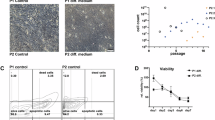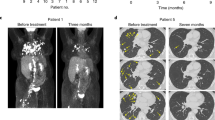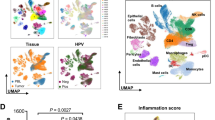Abstract
Alteration of the p16/pRb pathway may cooperate with telomerase activation during cellular immortalization and tumour progression. We studied p16 expression status by immunohistochemistry and telomerase activity using the TRAP assay in 21 premalignant lesions of the head and neck epithelium as well as 27 squamous-cell carcinomas. We also examined expression of other components of the pathway (cyclin D1 and pRb) as well as presence of human papillomavirus genomes which can target these molecules. 4 of 9 mild dysplastic lesions (44%), 8 of 12 moderate/severe dysplastic lesions (67%), and 25 of 27 squamous-cell carcinomas (92%) demonstrated high telomerase activity (P = 0.009). There was a parallel increase with severity of lesions for the trend in proportions of cases demonstrating p16 inactivation or cyclin D1 overexpression (P = 0.02 and P = 0.01, respectively). For Ki67, a marker of cell proliferation, this trend was not significant (P = 0.08). Human papillomavirus infection was only found in 4 cases among the 48 samples tested (8.3%). In conclusion, progression of disease is accompanied by a parallel and continuous increase in telomerase activity and alterations in cell cycle regulators (p16, cyclin D1), as proposed by in vitro models. © 2001 Cancer Research Campaign
Similar content being viewed by others
Article PDF
Change history
16 November 2011
This paper was modified 12 months after initial publication to switch to Creative Commons licence terms, as noted at publication
References
Bartkova J, Lukas J, Muller H, Strauss M, Gusterson B and Bartek J (1995) Abnormal patterns of D-type cyclin expression and G1 regulation in human head and neck cancer. Cancer Res 55: 949–956
Crissman JD and Zarbo RJ (1989) Dysplasia, in situ carcinoma, and progression to invasive squamous cell carcinoma of the upper aerodigestive tract. Am J Surg Pathol 13: 5–16
Dellambra E, Golisano O, Bondanza S, Siviero E, Lacal P, Molinari M, D’Atri S and De Luca M (2000) Downregulation of 14–3–3sigma prevents clonal evolution and leads to immortalization of primary human keratinocytes. J Cell Biol 149: 1117–1130
Dhaene K, Wauters J, Weyn B, Timmermans JP and van Marck E (2000) Expression profile of telomerase subunits in human pleural mesothelioma. J Pathol 190: 80–85
Dickson MA, Hahn WC, Ino Y, Ronfard V, Wu JY, Weinberg RA, Louis DN, Li FP and Rheinwald JG (2000) Human keratinocytes that express hTERT and also bypass a p16(INK4a)-enforced mechanism that limits life span become immortal yet retain normal growth and differentiation characteristics. Mol Cell Biol 20: 1436–1447
Edington KG, Loughran OP, Berry IJ and Parkinson EK (1995) Cellular immortality: a late event in the progression of human squamous cell carcinoma of the head and neck associated with p53 alteration and a high frequency of allele loss. Mol Carcinog 13: 254–265
Emig R, Magener A, Ehemann V, Meyer A, Stilgenbauer F, Volkmann M, Wallwiener D and Sinn HP (1998) Aberrant cytoplasmic expression of the p16 protein in breast cancer is associated with accelerated tumour proliferation. Br J Cancer 78: 1661–1668
Gazzeri S, Gouyer V, Vour’ch C, Brambilla C and Brambilla E (1998) Mechanisms of p16INK4A inactivation in non small-cell lung cancers. Oncogene 16: 497–504
Geradts J, Hu SX, Lincoln CE, Benedict WF and Xu HJ (1994) Aberrant RB gene expression in routinely processed, archival tumor tissues determined by three different anti-RB antibodies. Int J Cancer 58: 161–167
Greenberg RA, Chin L, Femino A, Lee KH, Gottlieb GJ, Singer RH, Greider CW and DePinho RA (1999) Short dysfunctional telomeres impair tumorigenesis in the INK4a(delta2/3) cancer-prone mouse. Cell 97: 515–525
Gruis NA, van der Velden PA, Sandkuijl LA, Prins DE, Weaver-Feldhaus J, Kamb A, Bergman W and Frants RR (1995) Homozygotes for CDKN2 (p16) germline mutation in Dutch familial melanoma kindreds. Nat Genet 10: 351–353
Haik S, Gauthier LR, Granotier C, Peyrin JM, Lages CS, Dormont D and Boussin FD (2000) Fibroblast growth factor 2 upregulates telomerase activity in neural precursor cells. Oncogene 19: 2957–2966
Huschtscha LI and Reddel RR (1999) p16(INK4a) and the control of cellular proliferative life span. Carcinogenesis 20: 921–926
Izzo JG, Papadimitrakopoulou VA, Li XQ, Ibarguen H, Lee JS, Ro JY, El-Naggar A, Hong WK and Hittelman WN (1998) Dysregulated cyclin D1 expression early in head and neck tumorigenesis: in vivo evidence for an association with subsequent gene amplification. Oncogene 17: 2313–2322
Jares P, Fernandez PL, Nadal A, Cazorla M, Hernandez L, Pinyol M, Hernandez S, Traserra J, Cardesa A and Campo E (1997) p16MTS1/CDK4I mutations and concomitant loss of heterozygosity at 9p21–23 are frequent events in squamous cell carcinoma of the larynx. Oncogene 15: 1445–1453
Jones DL and Munger K (1996) Interactions of the human papillomavirus E7 protein with cell cycle regulators. Semin Cancer Biol 7: 327–337
Kinoshita I, Dosaka-Akita H, Mishina T, Akie K, Nishi M, Hiroumi H, Hommura F and Kawakami Y (1996) Altered p16INK4 and retinoblastoma protein status in non-small cell lung cancer: potential synergistic effect with altered p53 protein on proliferative activity. Cancer Res 56: 5557–5562
Kiyono T, Foster SA, Koop JI, McDougall JK, Galloway DA and Klingelhutz AJ (1998) Both Rb/p16INK4a inactivation and telomerase activity are required to immortalize human epithelial cells [see comments]. Nature 396: 84–88
Klingelhutz AJ, Foster SA and McDougall JK (1996) Telomerase activation by the E6 gene product of human papillomavirus type 16. Nature 380: 79–82
Kolquist KA, Ellisen LW, Counter CM, Meyerson M, Tan LK, Weinberg RA, Haber DA and Gerald WL (1998) Expression of TERT in early premalignant lesions and a subset of cells in normal tissues. Nat Genet 19: 182–186
Kratzke RA, Greatens TM, Rubins JB, Maddaus MA, Niewoehner DE, Niehans GA and Geradts J (1996) Rb and p16INK4a expression in resected non-small cell lung tumors. Cancer Res 56: 3415–3420
Lin AW, Barradas M, Stone JC, van Aelst L, Serrano M and Lowe SW (1998) Premature senescence involving p53 and p16 is activated in response to constitutive MEK/MAPK mitogenic signaling. Genes Dev 12: 3008–3019
Loughran O, Clark LJ, Bond J, Baker A, Berry IJ, Edington KG, Ly IS, Simmons R, Haw R, Black DM, Newbold RF and Parkinson EK (1997) Evidence for the inactivation of multiple replicative lifespan genes in immortal human squamous cell carcinoma keratinocytes. Oncogene 14: 1955–1964
Mao L, El-Naggar AK, Fan YH, Lee JS, Lippman SM, Kayser S, Lotan R and Hong WK (1996) Telomerase activity in head and neck squamous cell carcinoma and adjacent tissues. Cancer Res 56: 5600–5604
Moses LE, Emerson JD and Hosseini H (1984) Analyzing data from ordered categories. N Engl J Med 311: 442–448
Munro J, Stott FJ, Vousden KH, Peters G and Parkinson EK (1999) Role of the alternative INK4A proteins in human keratinocyte senescence: evidence for the specific inactivation of p16INK4A upon immortalization. Cancer Res 59: 2516–2521
Mutirangura A, Supiyaphun P, Trirekapan S, Sriuranpong V, Sakuntabhai A, Yenrudi S and Voravud N (1996) Telomerase activity in oral leukoplakia and head and neck squamous cell carcinoma. Cancer Res 56: 3530–3533
Nakano K, Watney E and McDougall JK (1998) Telomerase activity and expression of telomerase RNA component and telomerase catalytic subunit gene in cervical cancer. Am J Pathol 153: 857–864
Okami K, Reed AL, Cairns P, Koch WM, Westra WH, Wehage S, Jen J and Sidransky D (1999) Cyclin D1 amplification is independent of p16 inactivation in head and neck squamous cell carcinoma. Oncogene 18: 3541–3545
Olshan AF, Weissler MC, Pei H, Conway K, Anderson S, Fried DB and Yarbrough WG (1997) Alterations of the p16 gene in head and neck cancer: frequency and association with p53, PRAD-1 and HPV. Oncogene 14: 811–818
Pande P, Mathur M, Shukla NK and Ralhan R (1998) pRb and p16 protein alterations in human oral tumorigenesis. Oral Oncol 34: 396–403
Papadimitrakopoulou V, Izzo J, Lippman SM, Lee JS, Fan YH, Clayman G, Ro JY, Hittelman WN, Lotan R, Hong WK and Mao L (1997) Frequent inactivation of p16INK4a in oral premalignant lesions. Oncogene 14: 1799–1803
Planas-Silva MD and Weinberg RA (1997) The restriction point and control of cell proliferation. Curr Opin Cell Biol 9: 768–772
Quelle DE, Zindy F, Ashmun RA and Sherr CJ (1995) Alternative reading frames of the INK4a tumor suppressor gene encode two unrelated proteins capable of inducing cell cycle arrest. Cell 83: 993–1000
Reed AL, Califano J, Cairns P, Westra WH, Jones RM, Koch W, Ahrendt S, Eby Y, Sewell D, Nawroz H, Bartek J and Sidransky D (1996) High frequency of p16 (CDKN2/MTS-1/INK4A) inactivation in head and neck squamous cell carcinoma. Cancer Res 56: 3630–3633
Resnick RM, Cornelissen MT, Wright DK, Eichinger GH, Fox HS, ter Schegget J and Manos MM (1990) Detection and typing of human papillomavirus in archival cervical cancer specimens by DNA amplification with consensus primers. J Natl Cancer Inst 82: 1477–1484
Sanchez-Cespedes M, Reed AL, Buta M, Wu L, Westra WH, Herman JG, Yang SC, Jen J and Sidransky D (1999) Inactivation of the INK4A/ARF locus frequently coexists with TP53 mutations in non- small cell lung cancer. Oncogene 18: 5843–5849
Serrano M, Lee H, Chin L, Cordon-Cardo C, Beach D and DePinho RA (1996) Role of the INK4a locus in tumor suppression and cell mortality. Cell 85: 27–37
Serrano M, Lin AW, McCurrach ME, Beach D and Lowe SW (1997) Oncogenic ras provokes premature cell senescence associated with accumulation of p53 and p16INK4a. Cell 88: 593–602
Shay JW and Bacchetti S (1997) A survey of telomerase activity in human cancer. Eur J Cancer 33: 787–791
Sumida T, Hamakawa H, Sogawa K, Sugita A, Tanioka H and Ueda N (1999) Telomerase components as a diagnostic tool in human oral lesions. Int J Cancer 80: 1–4
Wu CL, Roz L, McKown S, Sloan P, Read AP, Holland S, Porter S, Scully C, Paterson I, Tavassoli M and Thakker N (1999) DNA studies underestimate the major role of CDKN2A inactivation in oral and oropharyngeal squamous cell carcinomas. Genes Chromosomes Cancer 25: 16–25
Yoo GH, Xu HJ, Brennan JA, Westra W, Hruban RH, Koch W, Benedict WF and Sidransky D (1994) Infrequent inactivation of the retinoblastoma gene despite frequent loss of chromosome 13q in head and neck squamous cell carcinoma. Cancer Res 54: 4603–4606
Zhang SY, Klein-Szanto AJ, Sauter ER, Shafarenko M, Mitsunaga S, Nobori T, Carson DA, Ridge JA and Goodrow TL (1994) Higher frequency of alterations in the p16/CDKN2 gene in squamous cell carcinoma cell lines than in primary tumors of the head and neck. Cancer Res 54: 5050–5053
Zhu J, Woods D, McMahon M and Bishop JM (1998) Senescence of human fibroblasts induced by oncogenic Raf. Genes Dev 12: 2997–3007
Author information
Authors and Affiliations
Rights and permissions
From twelve months after its original publication, this work is licensed under the Creative Commons Attribution-NonCommercial-Share Alike 3.0 Unported License. To view a copy of this license, visit http://creativecommons.org/licenses/by-nc-sa/3.0/
About this article
Cite this article
Soria, J., Morat, L., Commo, F. et al. Telomerase activation cooperates with inactivation of p16 in early head and neck tumorigenesis. Br J Cancer 84, 504–511 (2001). https://doi.org/10.1054/bjoc.2000.1647
Received:
Revised:
Accepted:
Published:
Issue date:
DOI: https://doi.org/10.1054/bjoc.2000.1647
Keywords
This article is cited by
-
Host proteome linked to HPV E7-mediated specific gene hypermethylation in cancer pathways
Infectious Agents and Cancer (2020)
-
New cancer cases in France in 2015 attributable to infectious agents: a systematic review and meta-analysis
European Journal of Epidemiology (2018)
-
Telomeres and telomerase in head and neck squamous cell carcinoma: from pathogenesis to clinical implications
Cancer and Metastasis Reviews (2016)



